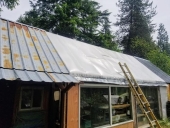posted 9 years ago
It is inspired by the earth-bermed solar greenhouses that have been feeding northern China for decades. The north wall should, ideally, be bermed into a hillside with a reinforced concrete retaining wall and finished to the apex with an insulated wall.
The geodesic endcaps really don't add all that much other than making it somewhat stronger and look like a giant dragonfly head. The tunnel section will be much weaker and needs regular support posts to keep it from sagging.
Some other rambling thoughts--
I am also inspired by the hybird high tunnels that folks are often using in the summertime, now, to be able to control precipitation and other environmental factors. Any greenhouses constructed these days should definitely be versatile enough to adapt to climate change and not overheat in the summer.
Once the solar angle on the roof gets beyond about 35 degrees (at my latitude) it should be shaded during the summer and insulated in winter. For this design, I would have a row of 4ft high operable windows along the bottom south wall and some long, insulated, double-swing roof vents (similar to newer high tunnels and greenhouses but unglazed). The roof vents would be conveniently accessible from the hillside. operable with a hooked pole. My preferred glazing is Acrylite Alltop. It is almost as expensive as glass but far and away the best option I have found.
I would also catch rainwater off the greenhouse and store it inside in large water cisterns along the back wall (potentially partially buried, although this might cause trouble with the foundation wall), which will reduce irrigation temperature shock and add thermal mass.
The design would also utilize a PAHS insulative blanket (I am fortunate enough to have enough sacrificial ground around the structure to do this). This would ensure a very long thermal flywheel, such that the greenhouse should not require any additional heat inputs after the first couple years (until then, I might utilize a simple passive solar pool heater to heat the rain storage water in the winter. I might also use a Jean Pain mound when I have available free wood chips.
Traditional Chinese greenhouses would have an attached cottage for the worker(s) and a pigsty for collecting concentrated manure for biogas for fuel and heat for the occupants and CO2 for the plants. I would also like to put a small cottage on a second bermed pad above the greenhouse that could vent some excess heat off the greenhouse in the winter.
Geosolar-greenhouse1.png
![Filename: Geosolar-greenhouse1.png
Description: [Thumbnail for Geosolar-greenhouse1.png]](/t/59520/a/44330/thumb-Geosolar-greenhouse1.png)
Geosolar-greenhouse2.png
![Filename: Geosolar-greenhouse2.png
Description: [Thumbnail for Geosolar-greenhouse2.png]](/t/59520/a/44331/thumb-Geosolar-greenhouse2.png)
Geosolar-greenhouse3.png
![Filename: Geosolar-greenhouse3.png
Description: [Thumbnail for Geosolar-greenhouse3.png]](/t/59520/a/44332/thumb-Geosolar-greenhouse3.png)









